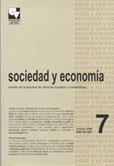Las redes del conflicto: el caso del Valle del Cauca
Published:
2004-07-15
Keywords:
Teoría de grafos, Conflicto, Redes, Interacción EstratégicaMain Article Content
This paper applies graph theory’s tools to the analysis of the armed conflict in
the Valle del Cauca region. Armed agents are studied like networks which interact
with each other in local contexts, but have global effects. Geographical places are
represented by nodes of a graph, and to each node is associated a state of control that emerges from the original interaction setting. Results include localization preferences, non correlation between activity on adjacent nodes, and concentration of actions on individual nodes. All results depend on agents’ local interaction.
the Valle del Cauca region. Armed agents are studied like networks which interact
with each other in local contexts, but have global effects. Geographical places are
represented by nodes of a graph, and to each node is associated a state of control that emerges from the original interaction setting. Results include localization preferences, non correlation between activity on adjacent nodes, and concentration of actions on individual nodes. All results depend on agents’ local interaction.
1.
Castillo M del P. Las redes del conflicto: el caso del Valle del Cauca. soc.eco [Internet]. 2004 Jul. 15 [cited 2026 Jan. 2];(7):25-44. Available from: https://sociedadyeconomia.univalle.edu.co/index.php/sociedad_y_economia/article/view/4148
Downloads
Download data is not yet available.

This work is licensed under a Creative Commons Attribution-NonCommercial 4.0 International License.
Revista sociedad y economía editada por la Facultad de Ciencias Sociales y Económicas de la Universidad del Valle se encuentra bajo una Licencia Internacional Creative Commons Atribución - No comercial 4.0
Basada en una obra en http://sociedadyeconomia.univalle.edu.co

